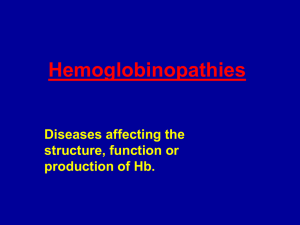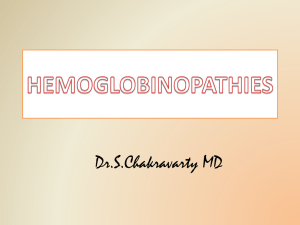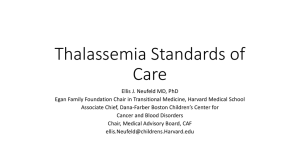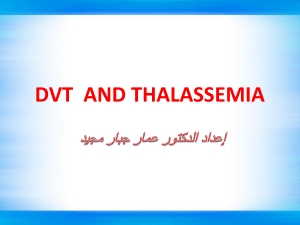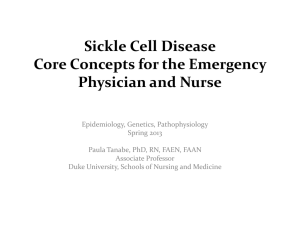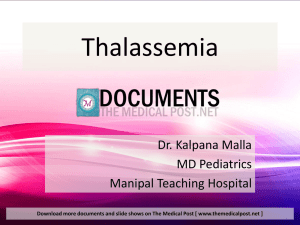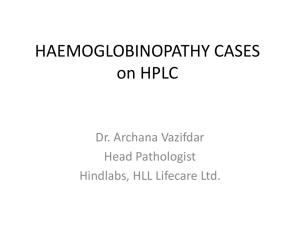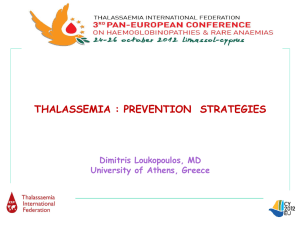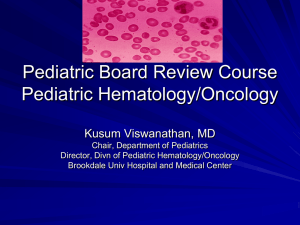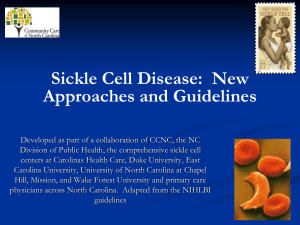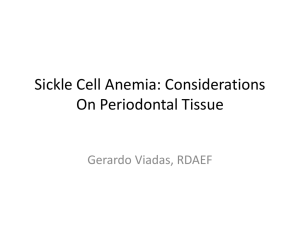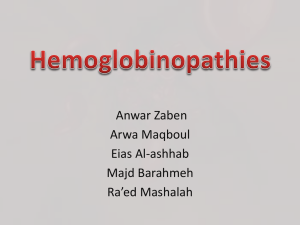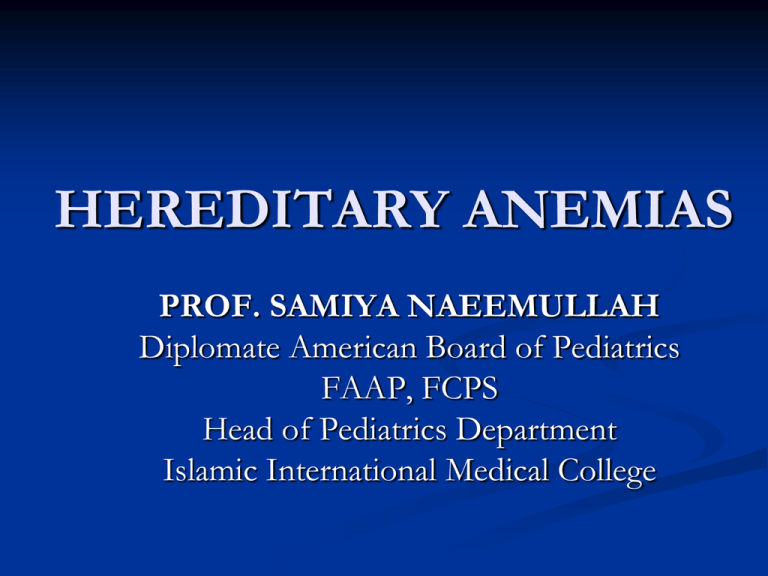
HEREDITARY ANEMIAS
PROF. SAMIYA NAEEMULLAH
Diplomate American Board of Pediatrics
FAAP, FCPS
Head of Pediatrics Department
Islamic International Medical College
ANEMIA
Defined as HB level below normal range
Varies with age and sex of the individual
Neonate
1-12 months:
1- 12 years
Hb < 14 g/dl
Hb <10 g/dl
Hb < 11 g/dl
IMPAIRED RED CELL PRODUCTION
Congenital Red cell aplasia
Diamond Blackfan Anemia
Fanconi Anemia
INCREASED RED CELL
DESTRUCTION
Hemolytic Anemias
RED CELL MEMBRANE DISORDERS
Hereditary Spherocytosis
RED CELL ENZYME DISORDER
Glucose 6 – phosphate dehydrogenase
deficiency (G6PD)
Hemoglobinopathies
Sickle cell disease
Thalassemia
LEARNING OBJECTIVES
Discuss the etiology of different types of hereditary
anemias?
Differentiate between cell defects, enzymatic defects
and hemoglobinopathies
Be able to distinguish the morphology of different
hemolytic anemias
Discuss clinical features of sickle cell disease and
Thalassemia Major
Correlate clinical features with pathophysiology of the
disease
DIAMOND BLACKFAN ANEMIA
Etiology
Autosomal dominant 15%
Autosomal recessive 15%
Spradic 80%
FH 20%
ANEMIA
CONGENITAL ANOMALIES
Short stature
DIAGNOSIS
Low Hb% macrocyte
Low reticulocyte Count
Normal bilirubin
Absent red cell precussors on narrow
INHERITED APLASTIC ANEMIAS
Reduction or absence of all three main line
in bone marrow leading to peripheral
blood pancytopenia
FANCONI’S ANEMIA
Short stature
Abnormal radii & thumbs
Renal manifestation
Pigmented skin lesion
Increased chromosomal breakage of
peripheral blood lymphocytes
Schwachman Diamond Syndrome
Autosomal Recessive disorder
Bone marrow failure
Pancreatic exocrine failure
Skeletal abnormalities
RED CELL MEMBRANE DISORDERS
Hereditary spherocytosis
Hereditary elliptocytosis
HEREDITARY SPHEROCYTOSIS
Autosomal dominant
No F/H – in 25% cases
Defect in genes for the skeletal proteins
of the red cells membrane spectrin,
ankyrin and band 3 red cell losses part
of its membrane passing through spleen
in surface to volume ratio – causes the
cells to become spheroidal.
Less deformable than normal RBS
Destruction in micro vasculature of the
spleen
Jaundice at birth
Anemia
Mild to moderate splenomegaly
Aplastic crises
Gall stones
ENZYME DEFECTS
Glucose 6 phosphate dehydrogenase (G6PD)
deficiency
Commonest red cell enzymopathy effecting over
100 million people world wide
G6PD in red cell essential for preventing
Oxidative damage to red cells
So cell lacking the enzyme are suseptible to
oxidant induced hemolysis
Etiology with inherited as X linked
effects males
G6PD activity in in Red cells
Mostly in old cells
X LINKED INHERITANCE
CLINICALLY
Neonatal Jaundice
Acute hemolysis precipitected by
Drugs
Infection
Naphthalene in moth balls
Intravascular hemolysis
Fever, malaise, dark colored urine
HEMOGLOBINOPATHIES
These are red blood cell disorders which
cause hemolytic anemia because of
Reduced or absent production of Hb A(
& thalassemia)
Production of abnormal Hb e.g. sickle cell
disease
BETA THALASSEMIA
AUTOSOMAL RECESSIVE
Inherited disorder characterized by
absence or decreased synthesis of beta
globin chain of hemoglobin
Normal Fetal Hb at different ages
At birth – 70%
5 weeks – 55%
4 months – 10%
5 month – 5%
At one year – (< 2%)
HETEROZYOUS SATE
Thalassemia Minor
One normal betaglobin chain gene and
one beta-thalassemia gene
HOMOZYGOUS
Thalassemia Intermedia
2 Thalassemia genes
Thalassemia Major
2 Beta thalassemia genes
PATHOPHYSIOLOGY
Beta Thalassemia minor
Most Common
Failure of one gene coding for beta chain
Alpha chain – production – normal
Alpha chain available combine with beta chain
Hb A levels
Excess alpha chain – stimulates production of
delta chain – Hb A2
Still excess alpha chains – switches off gamma
chain production does not function correctly.
And rate of gamma chain production is greater
than in normal adult so amount of Hb F.
HbF
Poor oxygen deliverer and high affinity for O2
Only functional Hb present is A2
Hypoxia
Erythropoetin
Stimulated marrow to maximum
Extremedullary hematopaiesis
Splenomegaly
CLINICAL MANIFESTATIONS
Thalassemia Minor
The Growth & Development is
normal
Mild anemia Hb – 10 mg./dl
Thalassemia Intermedia
Symptomatic by 2 – 4 yrs of age
Mod anemia
Thalassemic facies
Growth failure
Hepatosplenomegaly
Jaundice
THALASSEMIA MAJOR
DETROIT PEDIATRICIAN
1925
THOMAS COOLEY (Cooley Anemia)
Profound
anemia
Splenomegaly
Bony
deformities
Greek
word Thalasa SEA Blood
Universally fatal disease
Is now converted into chronic
illness
INCIDENCE
3% of world’s population carry Thalassemia
gene
PAKISTAN
Carrier rate 4-5%
Pathans
5.8%
Total No of patients 50,000-60,000
5000 – 6000 children are born each year
THALASSEMIA MAJOR
Born normal at birth
Starts getting pale,fussy,irritable
Starts refusing feeds
INFANT
CHILD
CLINICAL FEATURE
Bossing of skull
Maxillary overgrowth
Long face
Hepatosplenomegaly
Bones become thin
Fractures may occur
Heart failure
ADOLESCENT
COMPLICATIONS
Iron Overload
Darkening of skin(Iron stimulated melanin)
Cardiomyopathy
Endocrinopathies
Infections (Hepatitis A,B,C,Malaria,HIV)
Failure to thrive
Antibody formation(10%)Alloantibodies
LAB DIAGNOSIS
Complete Blood Count
RBC Morphology
Hemoglobin Electrophoresis
Serum Iron& Ferritin levels
Imaging Study
IRON OVERLOAD LEAD TO
Liver fibrosis
Cardiomyopathy
Dysfunction of endocrine organs
Diabetes
Clinical Organ dysfunction
Well transfused patient dies by 10-25 yrs if not
chelated
ADULT
Fertility
Ability to Reproduce and bare children
Reduce fertility due to iron overload
Control iron levels
Pregnancy monitoring, reproductive assistance and
perinotologist
40 cases reported
KEY MESSAGES
Screen the Population
Get The Blood Tested
Detect Thalessemia Traits
Prevent them from marrying other thalassemia
traits
Counselling
Help the children & families with Thalassemia
THALASSEMIA
Healthy infants have four globin genes.
The manifestation of thalassemic
syndromes depend on the number of
functional globlin chains
Deletion of 4 globin chains
Hb Barts Hydrops fetalis
Fetal anemia – edema, ascities
Fetus dies in utero or within hours of
delivery
Deletion of three globin genes
(HbH disease)
Mild – moderate anemia
Deletion of one or two globin chains
thalassemia trait
Asymptomic
Anemia is mild or absent
SICKLE CELL DISEASE HbSS
Commonest genetic disorders in UK in 2000
births
Blacks from tropical Africa
Etiology
Point mutation in codon 6 of globin chain
which causes change in aminoacid encoded from
Glutamine to Valine
FORMS
Sickle cell anemia
SC disease
Sickle thalassemia
SICKLE CELL ANEMIA HbSS
Patients are hemozygons for Hbs i.e.
virtually all their Hb is Hbs
No HbA – no normal genes
SC DISEASE
Affected children inherit
Hbs – one parent
HbC- other parent
SICKLE THALASSEMIA
Affected children inherit
Hbs from – one parent
thalassemia – trait – 2nd parent
No normal -globin genes and most patients
can make no Hb A so can transmit Hb S to their
offspring
Symptoms are similar to those with sickle cell
anemia.
SICKLE TRAIT
Inheritance of HbS from one parent
Normal - globin gene – other parent
40% of the Hb is HbS
Carriers of HbS
Asymptomatic
CLINICAL MANIFESTATIONS
Anemia 6 – 8 gm/d
Jaundice
VASO - OCCLUSIVE CRISES
Late infancy
Hand – foot syndrome
Bones of limbs & spine
Cerebral & pulmonary infarction
Acute stroke
PRECIPITATING FACTORS
Exposure to cold
Dehydration
Excessive exercise
Stress
Hypoxia
Infection
ACUTE ANEMIA
Hemolytic crisis
Associated with infection
Aplastic crisis
By parvo virus infection
complete or temporary caestion of red blood
cell production
Sequestration crisis
Sudden splenic enlargement
Abdominal pain
Circulatory collapse
INFECTIONS
Susceptibily to infections as pneumococcus &
hemophitus influenzae
Increased incidence of Bone infection by
salmonella
Chronic sickling microinfarction in spleen
Neonatal Diagnosis – at birth guthrie
test
Prenatal diagnosis by chorionic villus
sampling at the end of 1sttrimester
MANAGEMENT STEPS
Regular red cell transfusions
Chelation therapy
Growth monitoring and follow up
Management of complications
Psychosocial support
MANAGEMENT STEPS
Splenectomy
Bone marrow transplantation
Cord blood transplantation
Drugs stimulating gamma chains
Gene therapy
Prevention and antenatal diagnosis
MULTI DISCIPLINARY
APPROACH
Pediatrician
Hematologist
Gynecologist
Physician
Surgeon
Ophthalmologist
E NT Specialist
Lab technician
Psychologist
psychiatrist
Social worker
Parents
Patient

